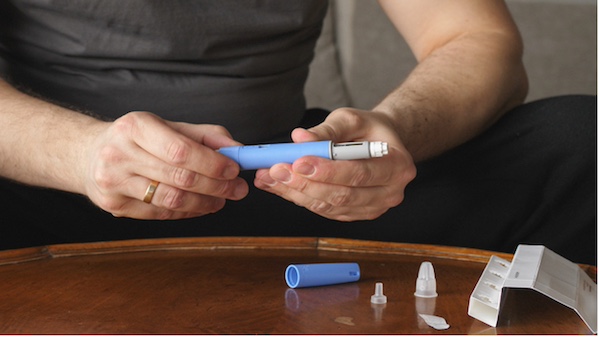Ozempic’s Pros, Cons and Correct Use Cases
October 16, 2023
Source: drugdu
 611
611
By George Kramb

Pictured: Man preparing Ozempic injection/iStock, imyskin
Thanks to TikTok, Ozempic has emerged as this year’s go-to weight loss drug. The current debate revolves around a need to understand Ozempic’s true benefits, unmarred by the overshadowing emphasis on weight loss.
Ozempic is not a weight loss drug. It is an injectable prescription medicine used “along with diet and exercise to improve blood sugar (glucose) in adults with type 2 diabetes,” according to its label. As such, it is crucial to recognize its multifaceted nature and the responsible approach it demands. Ozempic’s role in the evolving world of healthcare—and inadvertently weight loss—involves both medical benefits and societal perceptions.
The Authentic Benefits of Ozempic
Amidst the clamor surrounding Ozempic’s media coverage, it’s imperative to redirect the focus to its true advantages when employed for its designated purposes. Ozempic’s primary function lies in regulating blood sugar levels, offering crucial assistance to individuals grappling with diabetes by allowing them to achieve a more balanced equilibrium.
Ozempic’s active ingredient is semaglutide, which mimics the hormone glucagon-like-peptide-1 by targeting the areas of the brain that regulate appetite. This mechanism contributes significantly to controlling fluctuations in blood sugar levels—a pivotal aspect of effective diabetes management. This active ingredient allows the person taking the drug to think they are full, which then leads to weight loss.
Furthermore, while the focus has frequently centered around weight loss, it’s essential to contextualize this aspect within the broader spectrum of Ozempic’s merits. Emerging studies have revealed that individuals who use Ozempic as part of diabetes management often experience weight loss as an additional outcome. This weight loss effect, though promising, is best viewed as an accompanying result rather than the primary objective of Ozempic usage.
The Risks of Incorrect Usage
While Ozempic offers tangible benefits when used responsibly and under medical supervision, venturing into incorrect or off-label usage can carry substantial risks. There are significant hazards to using Ozempic without proper guidance or understanding of its intended purpose:
Unwanted side effects: Misusing Ozempic can lead to a range of adverse effects, which may include nausea, vomiting, diarrhea and stomach discomfort. Straying from the prescribed dosage or disregarding medical advice can amplify these side effects and compromise overall well-being.
Blood sugar imbalances: Ozempic’s primary function is to regulate blood sugar levels in individuals with type 2 diabetes. Using Ozempic without a diabetes diagnosis can result in imbalances in blood sugar, potentially causing hypoglycemia (low blood sugar) or hyperglycemia (high blood sugar).
Delayed diagnosis and treatment: Incorrect usage of Ozempic as a substitute for proper medical evaluation can mask and delay the diagnosis of underlying medical conditions. Inaccurate usage can hinder the timely initiation of appropriate treatments, exacerbating potential complications.
Ozempic’s benefits are best harnessed when aligned with its prescribed applications and administered under medical guidance. Engaging in informed dialogue with healthcare providers remains paramount to mitigate the dangers of incorrect or uninformed usage.
Beyond Medicine: Healthcare Social Experiences
In the realm of healthcare, uncertainty often prevails as individuals navigate conditions that lack definitive solutions. This parallels the multifaceted nature of Ozempic, where the complexities of healthcare become apparent. Accepting this uncertainty requires collaboration between healthcare providers and patients to make informed decisions that align with individual needs and circumstances.
Social experiences wield significant influence over healthcare decisions. From peer stories to online communities and social media platforms, they shape perceptions of pharmaceuticals and treatments. The case of Ozempic exemplifies how social media can amplify both success stories and misconceptions, underscoring the importance of approaching these influences with a discerning mindset that values verified information and professional guidance.
An evolution toward greater empathy lies at the core of the future healthcare landscape. Beyond traditional prescriptions, the approach involves understanding individuals in their entirety—physically, mentally and emotionally. Ozempic’s journey reflects the need for an industry that treats patients as partners and addresses their diverse experiences, recognizing that healthcare encompasses far more than just diagnoses.
Ozempic’s role in healthcare symbolizes the need for a broader movement toward patient-centered care. It prompts us to envision a future where healthcare transcends its traditional boundaries, weaving experiences, perceptions and innovations into a cohesive tapestry. Drug developers should look at social media exposure as an opportunity to involve more patients and influencers as they bring new medications to market. By partnering with patients who have success with their products and those who have less than satisfactory experiences, companies will learn valuable lessons to incorporate into future drug development efforts.
In fact, off-label use is not necessarily a bad thing, as that is how most “new” indications are identified. However, providers need to be very clear with the patient that they are using the therapy off-label.
This forward-thinking perspective not only acknowledges medical needs but also embraces the entire spectrum of individual well-being. Ultimately, Ozempic’s journey encourages us to envision a healthcare landscape characterized by trust, understanding and shared objectives between patients and practitioners.
Read more on
- Phase III Clinical Trial of Recombinant Staphylococcus Aureus Vaccine Progressing Normality January 21, 2026
- Its drug marketing application for injectable iza-bren has been accepted January 21, 2026
- Kain Technology withdrew a drug registration application, resulting in a profit reduction of 111 million yuan in 2025 January 21, 2026
- Received Notice of Approval for Drug Clinical Trial January 21, 2026
- Breaking news! AstraZeneca to be delisted from Nasdaq. January 21, 2026
your submission has already been received.
OK
Subscribe
Please enter a valid Email address!
Submit
The most relevant industry news & insight will be sent to you every two weeks.



